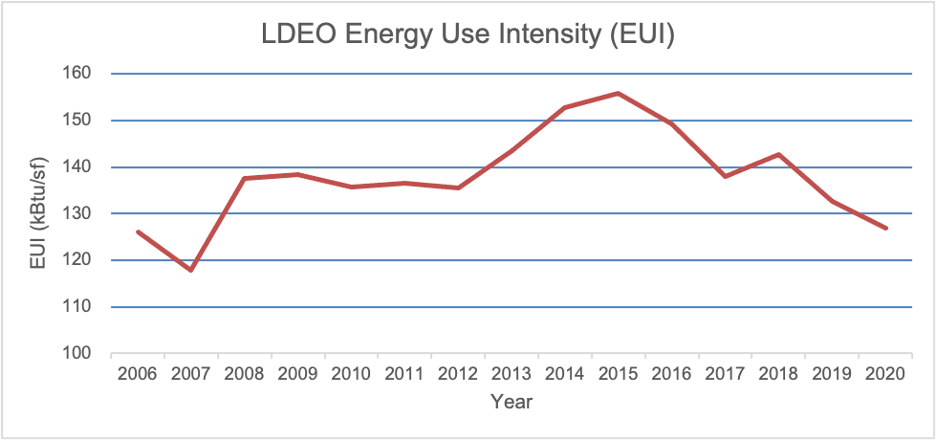Progress to Date
In Columbia’s first sustainability plan, Morningside+ set a goal of a 35% reduction in absolute emissions related to stationary combustion of fuel and purchased electricity, from a 2006 base year by 2020. Columbia met this goal in 2018 through a combination of fuel switching, energy conservation measures (ECMs), retro-commissioning measures (RCMs), and the purchase of hydropower and renewable energy credits (RECs) that allowed the University to successfully offset 100% of its reported emissions from electricity.
Since 2006, Columbia has seen reductions in absolute emissions, despite an increase of 7% in building square footage within the inventory boundary, and the inclusion of emissions from the transportation sector (commuting, owned or leased fleets, and business travel), waste from operations, and fugitive sources such as refrigerants and medical and research gases.
Beginning in 2018 and annually thereafter, Columbia has reported an offset of 100% of brown grid power emissions from electricity with the purchase of renewable energy credits. Columbia was also one of the first universities in the nation to introduce all-electric buses into its fleet, reducing annual emissions by over 70%.
Deep Energy Audit and Strategic Electrification
Between 2008 and 2020, New York City created numerous local laws to decarbonize the city’s energy sector. Local Law 17 created the Office of Long-Term Planning and Sustainability; Executive Order 26 committed New York City’s participation in the Paris Climate Agreement; and under Local Law 66, New York City committed to reducing its city-wide carbon emissions by 80% by 2050.
The most notable among all local laws is Local Law 97 (LL97), which passed in 2019. LL97 has often been recognized globally as the most ambitious law to tackle carbon emissions from existing and new construction buildings. Building owners or operators found to be in non-compliance face steep fines or penalties totaling millions of dollars every year until the year 2050. Columbia University Irving Medical Center (CUIMC) will have to reduce its buildings’ carbon emissions from 20% to 60% by 2030 to comply with LL97.
A comprehensive whole-building approach is needed to comply with the upcoming local laws in order to reach net zero emissions no later than 2050, as President Bollinger stated. CUIMC created a request for proposal (RFP) for a robust deep energy audit and strategic electrification of all heating sources in the buildings impacted by this law.
During the first half of 2020, various iterations of the RFP were reviewed and released for bids in conjunction with the procurement departments. Once the proposals were received, several rounds of interviews, site visits, and presentations were conducted to identify the most qualified firm that can complete CUIMC's RFP requirements within 365 days from the purchase date order.
The results from the deep energy audit and strategic electrification will be used to assess improvement measures, which will:
- Lead to near term energy savings.
- Provide a path/solution for electrification of heating systems.
- Provide a path/solution for 50% reduction in energy usage.
- Provide a path/solution for a net zero emissions campus by 2050.
The measures include, but are not limited to, reviewing the existing lighting system building envelope, water conservation, heating, ventilation, and air conditioning (HVAC) controls upgrades and strategies, chiller plant optimization, steam/boiler plant, central and terminal HVAC system, retro-commissioning, HVAC adjustments, pumps, motors, drives, domestic hot water systems, specialty and plug load systems, compressed air systems and renewable and distributed energy generation. CUIMC will receive one million dollars, or 56% of the project cost, from New York State Energy Research and Development as incentives against this RFP.
LDEO Mitigation Strategies
While LDEO agrees entirely with the goals of the University, the operations and maintenance profile of the Lamont campus is so significantly different from the other University campuses that it warrants an independent approach to mitigation. LDEO falls outside the municipal jurisdiction of NYC that regulates the rest of the University, and obtains its energy from a different utility company within a different New York Independent System Operator (NYISO) region. There is no central plant on the Lamont campus, heating systems are hydronic rather than steam, there is no residential occupancy, peak energy demands occur midday during a nominal 40 hour work week, there is no seasonality based on an academic calendar, and resiliency is a principle concern as pole-mounted utilities in a densely forested setting lead to frequent, long duration power outages. The research revenue only business model of LDEO creates unique financial challenges within the University, while the much smaller scale of LDEO operations creates unique opportunities for problem-solving without unreasonable risk.
1) Traditional Energy Conservation Measures (Avoid & Reduce)
LDEO will continue to improve existing infrastructure through its modest State of Good Repair and annual Capital Renewal budgets as opportunities present: providing new LED fixtures, additional insulation to exterior walls, ceilings, windows and doors, high efficiency boilers, variable frequency drive motors, reliable and efficient refrigerant charged equipment, dry coolers for free cooling to meet winter air conditioning demands, and natural gas replacements for diesel emergency generators.
2) Long-Term Renewable Energy Supply (Replace)
LDEO will maintain its power purchasing agreement (PPA) to provide 4 megawatts (MW) of solar power for the campus through 2040, at which time the entire NYS grid is assumed to achieve 100% zero emissions electricity. Onsite solar and additional remote net metered solar production will continue to be explored as a non-carbon source, and low carbon sources, such as very high efficiency co-generation and fuel cells are also under consideration. PPA arrangements are likely in all cases if financially satisfactory. REC purchases are likely to be required for the foreseeable future.
3) Strategic Electrification (Reduce and Replace)
The vast majority of Scope 1 emissions that remain to be addressed, and that pose the greatest challenge to achieving a net zero campus, is due to the combustion of natural gas in boilers and furnaces required to heat buildings, provide domestic hot water for bathing and cleaning, and reheat supply air to laboratories excessively refrigerated for humidity control. This demand is year-round, although, naturally, the demand peaks significantly in the winter months. Geothermal has been extensively studied at Lamont as having significant potential for new ground up building construction and retrofit for full building gut renovation projects. As LDEO has distributed, rather than centralized heating plants, strategic electrification may also be phased in for some buildings by systematic floor by floor mechanical room renovations connected to a shared geothermal or rooftop air to air heat pumps.
Offsets and Removal (Compensate and Neutralize)
Natural gas is likely to always be required on campus, if for no other reason than to support essential emergency generators. Similarly, refrigerants will need to be purchased each year to replace accidental releases, and gases with greenhouse potential, including CO2, will also be purchased for the research enterprise. So it is expected that voluntary carbon credits will be necessary to achieve the last several points towards a net zero campus. Of course, as carbon removal and sequestration is a field of research extensively explored by LDEO scientists, there may be some potential to achieve a strategic partnership with private industry that may inure to this benefit in some way in the long term.
LDEO Progress to Date
LDEO began tracking its carbon emissions in 2005, and established a goal of 30% reduction from a 2006 base year by 2017. Despite its best efforts at conservation, this initial goal proved elusive as the campus was in desperate need of modernized and expanded facilities to support its world class research enterprise. In 2007, LDEO replaced its existing Geochemistry laboratory building with the new Comer building, ventilated to modern standards for safety, dust, temperature, and humidity control, increasing the campus built footprint by 22%, and energy consumption by nearly 40%. The balance of the wet laboratories on campus were modernized to a similar standard through 2012 as the New Core Lab building was renovated and equipped with multiple independently controlled walk in incubators for biogeochemistry. At the same time, Information Technology (IT) infrastructure grew by leaps and bounds as gigabit bandwidth became available at every desktop, and server farms, large and small, sprung into existence and expanded across campus leveraging new computational technology for the storage and manipulation of petabyte data sets associated with global scale modeling. By 2014, Energy Use Intensity reached a peak at LDEO, with a peak in Absolute Carbon Emissions the following year.

Recognizing the futility of its energy conservation measures to offset the energy demands of aggressively modernizing the science facilities, LDEO Facilities Management sought to build a portfolio of non-carbon and low-carbon energy alternatives, ultimately determining that developing 4MW of remote net metered solar produced energy on two farms in an adjoining rural county through a 20 year PPA was a reasonable first step towards a more sustainable campus. In writing the University’s 2017 plan, LDEO was aware this solar production would come on line by 2018, thus it reset its baseline year to 2016, and established a goal of 50% reduction of absolute emissions by 2020.
In 2020, these solar farms replaced 86% of LDEO’s electric needs, and the balance was offset by a modest purchase of RECs by the University to achieve a 100% reduction of Scope 2 emissions. Eliminating the Scope 2 emissions resulted in a 52% reduction of absolute emissions for the campus, and the 2020 goal was achieved.
LDEO Carbon Inventory Statistics
- Parameters
- Buildings
- 2006
- 20
- 2016
- 21
- 2020
- 21
- Parameters
- Square Footage
- 2006
- 319,295
- 2016
- 390,784
- 2020
- 390,784
- Parameters
- Natural Gas Usage (CCF)
- 2006
- 179,830
- 2016
- 265,610
- 2020
- 227,231
- Parameters
- Electric Usage (kWh)
- 2006
- 6,397,353
- 2016
- 9,107,102
- 2020
- 8,356,451
- Parameters
- Total Energy Usage (kBtu)
- 2006
- 40,278,326
- 2016
- 58,325,018
- 2020
- 49,595,037
- Parameters
- Energy Use Intensity (kBtu/sq ft)
- 2006
- 126
- 2016
- 149
- 2020
- 133
- Parameters
- Renewable Energy Usage (kBtu)
- 2006
- 0
- 2016
- 0
- 2020
- 28,512,211
- Parameters
- Emissions (MTCO2e)
- 2006
- 1717
- 2016
- 2497
- 2020
- 1237
- Parameters
- Carbon Intensity (lbs/sq ft)
- 2006
- 11.83
- 2016
- 14.15
- 2020
- 6.97
